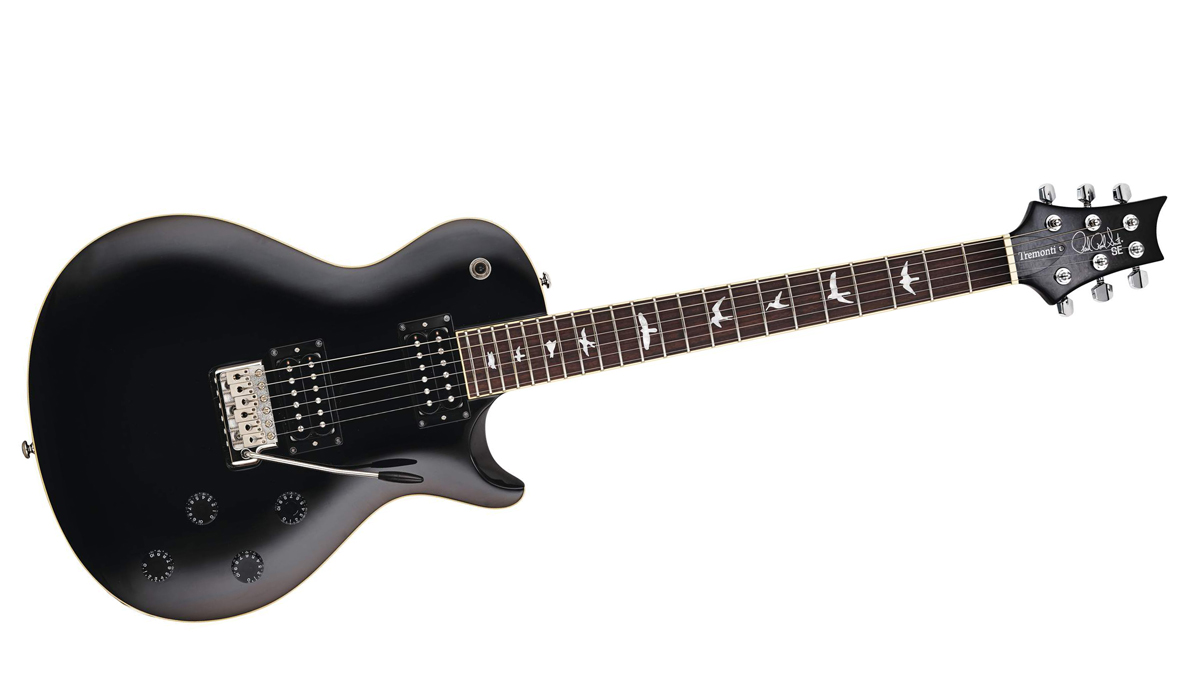MusicRadar Verdict
Standard? This guitar is anything but.
Pros
- +
Price.
- +
Build quality.
Cons
- -
The weight of our sample is excessive.
MusicRadar's got your back
The term ‘Standard’ might be applied to the most coveted glued-neck guitar there is but in traditional PRS lexicography, ‘Standard’ means without a maple top to differentiate it from the Custom.
Today, while there are no Standards in the USA Core lineup, they form a major part of the more rock ’n’ roll S2 line where these all-mahogany guitars are also ID’d by classic dot inlays rather than the trademark PRS birds. As we move further down the price scale the offshore-made SE line has a trio of Standards (245, Standard 24, and Standard 24 Multi-Foil) plus this new signature model, the 2018 Tremonti Standard. And with the exception of that Multi-Foil model, the big difference is the price, having been made in Indonesia, as opposed to Korea.
The Tremonti Standard ships with an opaque black finish, cream bound, meaning you can’t see any wood at all. It could be made of concrete for all we know as it weighs in at a whopping 4.41kg/9.7lb. By comparison our non-Standard Tremonti is more normal at 8.8lb while the Santana Standard weighs in at 7.7lb.
That said, the Singlecut is, by design, a weightier piece due to its shape and thicker depth body. While original SE Singlecuts had a thin 45mm deep body - the USA models are just under 60mm - here, like more recent spec, the Tremonti Standard measures a shade under 55mm overall, the Korean version 56mm.
The Mark Tremonti model is a unique piece and is the only Singlecut with a vibrato (with the exception of the Bigsby-equipped S2 Starla) anywhere in the PRS lineup. There’s little doubt that most of us prefer our single-cuts (PRS or other brands) in a more classic hardtail format yet it gives the Tremonti considerable appeal. However, with no options and just one colour, what you see is what you get.
The main differences - physical shape aside - to the Standard are a thinner depthed ‘wide thin’ neck profile, the pickups and the four-control layout in the diamond style (as opposed to Gibson) as featured on the first PRS Singlecuts that appeared in 2000. Unlike some PRS single-cuts the wiring here includes a treble bleed on each volume control and again the pickups have four-conductor wiring.
Sounds
There’s extra beef to the Tremonti and it’s not just that weight. There’s plenty of almost cocked wah midrange clout from the bridge that adds juice and sizzle to your front-end, combined with a heft in the low-end that any good single-cut guitar should posses.
But this bluster is again parried by the much more vintage-y neck voice that drops us back a little in time. The Standard version exhibits slightly less attacking upper midrange than the SE Tremonti but again the sounds are close. In fact, we might go for the bridge pickup of the Standard paired with the neck pickup on the non-Standard in terms of our favourite sounds.
Despite the near £300 price difference, this Standard holds up extremely well to its non-Standard stablemate. Like the other SE models there are no locking tuners here and you certainly need to be careful how you attach your strings - really stretch them in, not least with the added upbend of the Tremonti. We tightened the tuner buttons too which, while not changing the function, really does firm things up.
For a company that, from its inception, has been constantly criticised for the price of its instruments, this Standard almost feels like an impulse buy. With no gigbag and just the colour you see we’re hardly spoilt for choice but while you might have expected a ‘cheaper’ unbound satin finish with dot inlay specification, there’s very little to actually differentiate in feel or sound between these and the non-Standard signature.
Assuming the over-heavy Tremonti is a blip and not indicative of all the production models, this Standard not only gets you on the PRS ladder, but for existing PRS fans it’s a good knockabout guitar that won’t make you blub inconsolably when it gets dinged in action. It is also seriously good ‘spares’ and a rather good platform for any keen modders.
Dave Burrluck is one of the world’s most experienced guitar journalists, who started writing back in the '80s for International Musician and Recording World, co-founded The Guitar Magazine and has been the Gear Reviews Editor of Guitarist magazine for the past two decades. Along the way, Dave has been the sole author of The PRS Guitar Book and The Player's Guide to Guitar Maintenance as well as contributing to numerous other books on the electric guitar. Dave is an active gigging and recording musician and still finds time to make, repair and mod guitars, not least for Guitarist’s The Mod Squad.
“Excels at unique modulated timbres, atonal drones and microtonal sequences that reinvent themselves each time you dare to touch the synth”: Soma Laboratories Lyra-4 review
“I used everything I knew about music”: How Green Day exceeded expectations with their most ambitious song
YouTube just added AI tools that makes musicians, library music and video editors redundant











